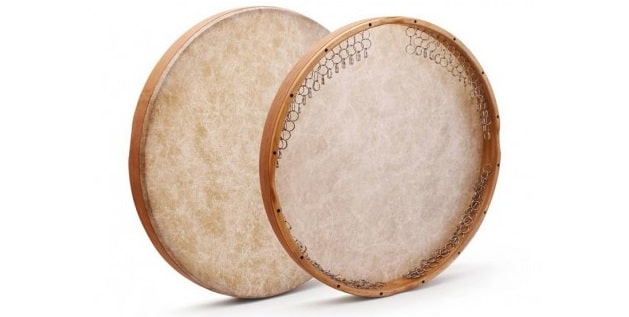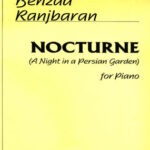
Researcher:
Mohammad Tarighat
Translator:
Fatemeh Alimohammadi
Hooks and attached rings: The junction of the ring to the arch is about 3 centimeters from the skin. The ring with its side rings should be as far as the diameter of a ring (about one and a half to one and eight centimeters) to make a proper arrangement and less interference of rings and clearer sound, it also helps to the lightness of the instrument (Mogharab Samadi, 2008: 79).
It is mentioned elsewhere that the distance of each hook from the skin is about three and a half centimeters and from the adjacent hook is about three centimeters. In each hook, there are four rings that the first and second rings are connected from above as a single and the next two rings are connected to the second ring in pairs (Tohidi, 1998: 83).
Khaktinat also mentions the position of the rings:
“We nail around the frame at a distance of three and a half to four centimeters from the opposite edge of the Avazeh. The distance between the nails is one to one and a half centimeters” (Khaktinat, 2005: 64).
To ensure the correct position of the rings, we put one of the fingers on the last ring, which is in pairs, and we move it towards the skin in an oblique shape; of course, the Daf should be standing and vertical. If only the lower pairs of rings hit the skin, they will be in the proper place and the sound will be of high quality. But if, in addition to the lower pair of Malilehs, the middle Malilehs normally come in contact with the skin, they are misplaced and cause excessive contact with the skin (same: 71).
Mohammadi says: “The distance between the hooks is one and a half centimeters, which one centimeter can be added to this distance, but the weight of the Daf will increase. The distance between the hooks and the skin is calculated as follows: Consider half of the width of arch and add half a centimeter from the skin side to it to be the exact location of the hooks “(Mohammadi, 2021). In the past, the diameter of the rings was two centimeters and their thickness was one to one and a half millimeters and they were made of brass and steel. Today, the rings are made of iron wire with a diameter of one and a half to one and eight centimeters and a thickness of about one millimeter.
Skin: Old, fat-free, clear and transparent skin of animals such as ewe and sheep, which put less elastic pressure on the arch and they are also very good (Mogharab Samadi, 2009: 79). Naqib Sardasht believes that the skins of animals such as sheep, goat, yeanling, lamb, ewe, mountain goat and deer are used and deer skin has been introduced as the best one (Naqib Sardasht, 2007: 295), but today due to the high cost and scarcity of deer skin, this skin is less used.
It should be noted that sheep skin is thicker and lighter than goat skin. The thickness of the skin used in Daf, is about one to two millimeters (Tohidi, 1998: 81). The most suitable sheep skin, which is called ” Kavor” in Kurdish, is a female, healthy, one-year old, and lean sheep (Hosseini, 2021). Today, the skin of animals such as sheep and goat with a thickness of less than one millimeter are used. The skin of fish and deer are useless due to their high cost and scarcity.
In terms of the type of sound produced, skins can be classified from tenor to bass sound in the following order:
- Fish skin;
- Goat skin;
- Deer skin;
- Ewe skin;
- Sheepskin;
- Calf skin;
- Camel skin (Khaktinat, 2005: 72).
The natural skins mentioned above change according to different weather conditions; due to heat, the skin becomes more elongated and so-called firmer, and in cold and humidity, it becomes free and so-called looser. For this purpose, some manufacturers use a kind of artificial or plastic skin in making Daf, and in some cases they use fibrous skin, which is consists of natural fibers and is stable in different weather conditions. This has caused changes in the structure and components of the Daf, including the removal of studs, changes in the strength and narrowing of the arch width, changes in the Avazeh of Daf, and etc.
Strap: When the duration of playing Daf is long, a strap is installed on the inner edge of the Daf, which the musician wraps around his wrist to reduce hand fatigue.







